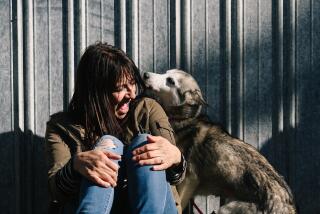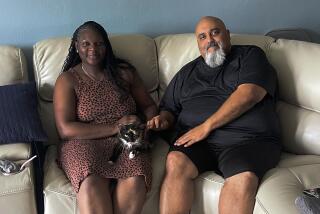She Just Might Be a Cat’s Best Friend
- Share via
Judy Cairns sits in the back of RTD’s 225 bus as it winds, bounces and squeaks down the Palos Verdes Peninsula.
She sits back there out of deference to fellow passengers, who have wrinkled up their noses because her bag--already aromatic with fishy cat food--acquired a skunk residue up on the hill. She set it down in the wrong spot on her twice-daily rounds.
Cairns, who lives in San Pedro, goes out seven days a week, in the morning and in the evening. She hauls bags and buckets of cat food and water for scores of felines in the Palos Verdes hills, one of two feral cat colonies she looks after. The other is at old Warehouse One at Los Angeles Harbor. She can’t leave more than one day’s food, because the cats will have to compete for it with raccoons, possums, skunks, rats, pigeons, gulls and other wildlife.
She has made her daily rounds for almost 10 years, feeding strays, befriending kittens and sustaining the newly abandoned in their hunger, fear and woe.
“I used to try to save the world, but I couldn’t afford it, so now I just try to save the cats,” Cairns says.
Counting bus fare, canned and kibbled cat food, and tools (“I wear out a brand-new $9 can opener every three weeks”), Cairns estimates that her labor of love costs her $400 a month. She gets occasional donations, but most support comes from her job as an automotive marketing researcher.
Her philosophy is to provide abandoned cats with food, adequate medical care and love--along with birth control. Cairns’ care includes taking cats to be spayed and neutered by volunteer veterinarians. Once spayed or neutered and well again, the cats are reunited with their colony.
Gradually, many feral cats, whether abandoned pets or the second- and third-generation offspring of wild and domestic felines, become tame enough--and willing enough--to be adopted. Meanwhile, sympathetic veterinarians accompany Cairns to check the colonies for disease or infection and administer medications.
A former race-car driver, Cairns learned her methods of feral cat care and population control on visits to Great Britain, when she was covering the international racing circuit as editor of a motor sports magazine.
She says some critics say the colonies should be eradicated humanely, because life in the wild, even with daily food and medical care, is too cruel for suburban felines. But Cairns disagrees. “They just don’t realize that not every cat needs a pillow in front of a fireplace,” Cairns says.
“Heeeeeerre . . . Kittykitty-kittykittykittykitty,” she calls, back in San Pedro, as the Angel’s Gate evening breeze whips around Warehouse One, where many movie and TV-show segments are filmed.
“Originally, they brought in the cats to catch the rats that infested the warehouse area,” she explains.
The cats begin to materialize. Cairns has named most of them: Lady Diana, Prince Charles (“He’s sort of haughty and arrogant . . . kind of royal”), Red Adair, Bill Clinton, Sister Mary Katherine, Rocky, David, Boomer, Fifi, Fluffy, Fast Freddie (“He isn’t”), Bozo, Motley, Sylvester and two Timmys, one up on the hill and another down in the harbor.
“When they get unafraid about getting near people or approaching residences, they’re about ready to be placed,” Cairns says. “I’ve had great luck with adoptions so far.
Cairns is also a friend to people in the neighborhood. “Whenever they’re shooting movie or TV segments down in the harbor, which is quite often, the catering companies that feed the crews always have a lot of leftovers. A lot of them know me now and they’ll save (the leftovers) for us.
“I always take the best of the catering leftovers to homeless people I know, and then give the scraps to the cats,” Cairns says.
“It’s been a long time since I was 29. So, this is either a major second childhood or a long middle-age crisis.
“But,” she says, “it is probably the least nuts thing that I’ve ever done.”
More to Read
Sign up for Essential California
The most important California stories and recommendations in your inbox every morning.
You may occasionally receive promotional content from the Los Angeles Times.













